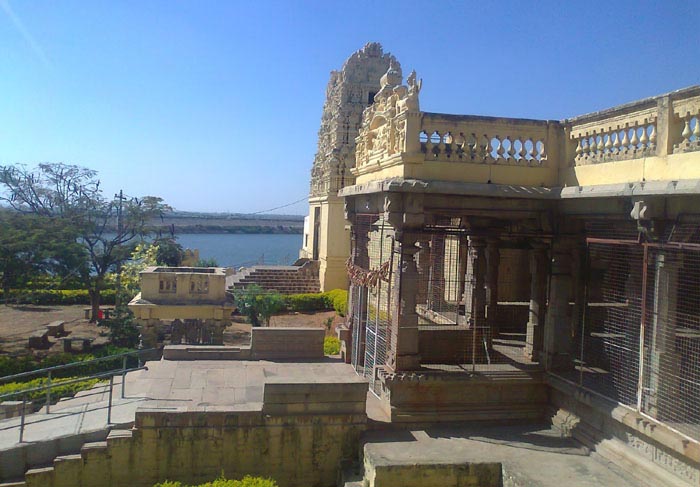Sri Ranganayaka Swamy Temple

Information of Sri Ranganayaka Swamy Temple, Srirangapuram, Mahbubnagar, Telangana
Sri Ranganayaka Swamy Temple is located in the village named Srirangapuram, in Pebbair, in the district of Mahabubnagar, in the state of Telangana, in South India. The primary deity of this shrine is Lord Sri Ranganayaka Swamy. It was built during the 18th century A.D. This shrine is nearly 100 km from Mahabubnagar, 160 km from Hyderabad, 12 km from Srirangapur, 12 km from Wanaparthy, 60 km from Kurnool, 10 km from Pebber and 25 km from Vanaparthy. As per local legends, the Vijayanagar ruler named Krishnadevaraya visited Srirangam and was really enthralled by the Lord Sri Ranganayakaswamy Temple at this place. He wholeheartedly desired immediately to construct in his kingdom a Ranganayakaswamy temple. Later, Lord Vishnu in the form of Ranganayaka appeared in his dream and mentioned the king that his perfect idol is hidden in his region and a smart eagle will direct him to that spot. The next day, the King followed the eagle and in a successful manner found the Lord's idol between Kanvayapally and Kothakota mountains. Near Ratna Pushkarini Lake, the king successfully constructed the Sri Ranganayaka swamy Temple.
Sri Ranganayaka Swamy Temple Religious Significance
Sri Ranganayaka Swamy Temple is visited by adherent devotees, pilgrims, visitors and tourists from the states of Maharashtra, Tamil Nadu, Karnataka and Andhra Pradesh with much dedication and commitment. A large number of people come from the district of Raichur and Gulbarga. At this shrine, most of the poojas, homams, yagnas and other religious activities and functions are performed as per Vedic rules and regulations with a lot of perfection. The local people of this village and its surrounding villages visit this shrine daily. The festivals and auspicious days are grandly celebrated with active participation of local people.
Sri Ranganayaka Swamy Temple Architectural Significance
Sri Ranganayaka Swamy Temple is a classic example of Vijayanagar architecture style and pattern. The temple was built by the Rajas of Wanaparthi Samsthanam on the bund of Ratna Pushpakarini Lake. It is purely blended with the South Indian Hindu architectural style and pattern too. It is a large sized temple with several building structures within the temple complex. It is fortified or four sided walled temple with main entrance and exist gateways in the oosite directions. There are many sub-temples in the complex that that are dedicated to Hindu major and minor Gods and Goddesses. The Rajagopuram of this shrine is very large when compared to other local temples of this region. This shrine is known among the people for its unique architectural features which make them look in wonder. The shrine has many beautifully and attractively carved pillars and ceilings. The flooring of this shrine needs a special mention for its unique specialty in several aspects. It is to be noted that different types of huge sized stones are used in the making of this temple.
Festivals at Sri Ranganayaka Swamy Temple
Sri Ranganayaka Swamy Temple is known among the adherent devotees, pilgrims, visitors and tourists from the states of Maharashtra, Tamil Nadu, Karnataka, Telangana and Andhra Pradesh for the grand celebration of 'Rathotsavam' during March; 'Kotai Vutsavalu' during Sankranti Festival Days; 'Navaratrulu' during Dasara Festival, and during Sravanamasam. There is very high flow of tourists and visitors during these auspicious and festive days. The shrine is brightly illuminated during these days with light arrangements and flower decorations. The shrine witness good rush and queue system is followed in a strict manner in order to control crowd management in all aspects. The temple authorities follow Vedic rules and regulations in the pooja and secial homams.
- Andhra Pradesh Temples
- Assam Temples
- Bihar Temples
- New Delhi Temples
- Goa Temples
- Gujarat Temples
- Jammu and Kashmir Temples
- Karnataka Temples
- Kerala Temples
- Madhya Pradesh Temples
- Maharashtra Temples
- Odisha Temples
- Punjab Temples
- Rajasthan Temples
- Sikkim Temples
- Tamil Nadu Temples
- Telangana Temples
- Uttar Pradesh Temples
- Uttarakhand Temples
- West Bengal Temples